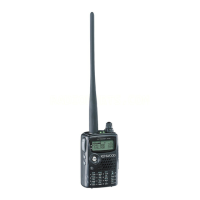12
OPERATING THROUGH REPEATERS
Repeaters, which are often installed and maintained
by radio clubs, are usually located on mountain tops
or other elevated locations. Generally they operate at
higher ERP (Effective Radiated Power) than a typical
station. This combination of elevation and high ERP
allows communications over much greater distances
than communications without using repeaters.
Most repeaters use a receive and transmit frequency
pair with a standard or non-standard offset (odd-split).
In addition, some repeaters must receive a tone from
the transceiver to allow it to access. For details,
consult your local repeater reference.
OFFSET PROGRAMMING FLOW
If you store the above data in a memory channel, you
need not reprogram every time. See “MEMORY
CHANNELS” {page 15}.
PROGRAMMING OFFSET
First select an amateur radio repeater downlink
frequency on the A-band or B-band as described in
“SELECTING A FREQUENCY” {page 7}.
■ Selecting Offset Direction
Select whether the transmit frequency will be
higher (+) or lower (–) than the receive frequency.
Press [F], [REV] to select the offset direction.
• “+” or “–” appears, indicating which offset
direction is selected.
•To program –7.6 MHz offset on the TH-F7A
(430 MHz only), repeatedly press [F], [REV]
until “ ” appears.
If the offset transmit frequency falls outside the
allowable range, transmitting is inhibited. In this
case, adjust the receive frequency so that the
transmit frequency is within the band limits.
Note: While using an odd-split memory channel or
transmitting, you cannot change the offset direction.
■ Selecting Offset Frequency
To access a repeater which requires an odd-split
frequency pair, change the offset frequency from
the default which is used by most repeaters. The
default offset frequency on the 2 m band is
600 kHz; the default on the 70 cm band is 1.6
MHz.
1 Press [BAND] to select an amateur radio band
you want to change the offset frequency.
2 Press [MNU].
3 Turn the Tuning control or press [ ]/ [ ] to
select Menu No. 6 (OFFSET).
4 Press [ ] or [MNU].
5 Turn the Tuning control or press [ ]/ [ ] to
select the appropriate offset frequency.
• The selectable range is from 0.00 MHz to
59.95 MHz in steps of 50 kHz.
6 Press [ ] or [MNU] to store the setting.
Otherwise, press [PTT] to cancel.
Note:
◆ If you have selected “ ” for the offset direction, you cannot
change the default (–7.6 MHz) offset frequency.
◆ After changing the offset frequency, the new offset frequency
will also be used by Automatic Repeater Offset.
TX: 144.725 MHz
TX tone: 88.5 Hz
RX: 145.325 MHz
TX: 144.725 MHz
TX tone: 88.5 Hz
RX: 145.325 MHz
Select a band.
q
w
e
r
t
y
Select a receive frequency.
Select an offset direction.
Select an offset frequency
(only when programming odd-split
repeater frequencies).
Activate the Tone function
(if necessary).
Select a tone frequency
(if necessary).

